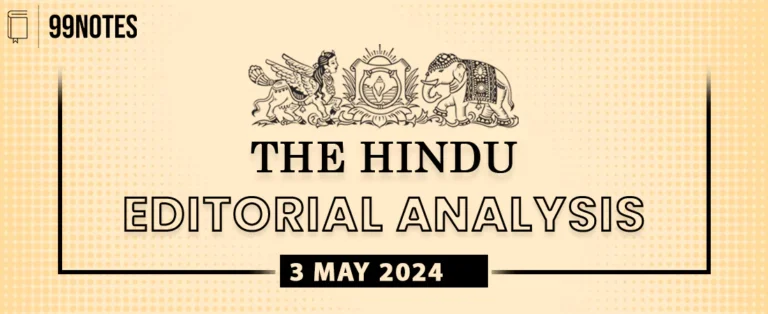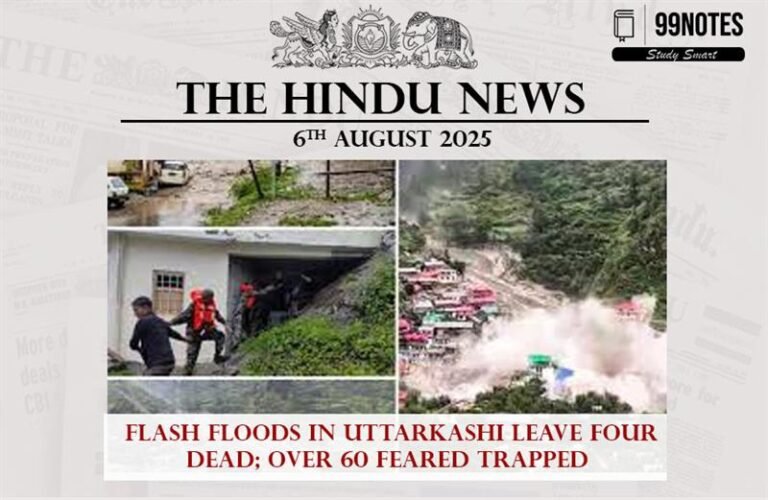2 December 2023 : The Hindu Editorial Notes PDF
The Hindu Editorial
2-December-2023
1. Improving the capability of the Indian state.
Topic: GS2 – Indian polity.
Challenges of Indian State Size:
- Paradox of Size: India’s bureaucratic processes are cumbersome, making it difficult to set up businesses or build houses due to a thicket of licenses, permits, and clearances.
- Weberian State Size: India’s state is paradoxically too small on global metrics, with the lowest number of civil servants per capita in the G-20. Public sector employment and the number of professionals in various critical areas are significantly lower than in other countries.
State Capability and Policy Implementation:
- Concentration of Powers: There’s an extreme concentration of policymaking and implementation powers within departments, hindering execution and innovation. Separation of these responsibilities, as seen in countries like Australia and the UK, can expedite execution and improve program adaptation to local contexts.
- Delegation and Accountability: Restrictions on frontline personnel’s decision-making foster mistrust and accountability issues. Breaking this cycle requires delegating financial and administrative powers to frontline functionaries with clear processes.
Technocratic Gap and Lateral Entry:
- Top Policymakers’ Lack of Skills: The top policymakers lack technocratic skills to deal with economic and technical matters, leading to heavy reliance on consultancy firms.
- Lateral Entry Solutions: Regular lateral entry at mid and senior levels, subject-specific training under Mission Karmayogi, and leveraging non-IAS services for high-level positions can address the technocratic gap.
Oversight and Audits:
- Audit Limitations: The Comptroller and Auditor General’s narrowly scoped audits focus on compliance with rules rather than policy objectives, causing delayed procurement and contractual disputes.
- Sensitizing Oversight Agencies: Oversight agencies need to appreciate the context of policy decisions, considering costs associated with decisions and alternatives to avoid unnecessary disputes.
Political Will and Regulatory Appointments:
- Retired Officers in Regulatory Bodies: Appointing retired officers to regulatory bodies and tribunals creates susceptibility to political manipulation. Increasing the retirement age and setting an absolute upper limit for all appointments can mitigate this.
- Incentivizing Public Sector Work: Intrinsic motivation, rather than performance-linked pay, is crucial in the public sector. Moderating pay raises by future Pay Commissions and reducing the upper age limit for government jobs can address corruption and attract socially-driven individuals.
Public versus Private Sector Dynamics:
- Salary Disparities: Relatively high salaries in the public sector, especially due to substantial hikes by Pay Commissions, lead to corruption in appointments.
- Solution: Moderate pay raises, reduction in the upper age limit for government jobs, and a thriving private sector can make government jobs less financially appealing, reducing corruption and attracting socially-driven individuals.
2. The ‘loss and damage’ fund is finally online but more needs to be done.
Topic: GS3 – climate financing
Operationalization of Loss and Damage (L&D) Fund:
- Historic Achievement: Representatives at COP28 in the UAE have agreed to operationalize the L&D fund, fulfilling a three-decade-old demand seen as a fundamental expression of climate justice.
- Steadfast Efforts: The G-77 bloc of countries plus China, led by Pakistan, played a crucial role in pushing for the establishment of the L&D fund, marking a diplomatic victory.
Key Issues and Concerns:
- World Bank Interim Hosting: The L&D fund will be hosted by the World Bank for an interim period of four years, raising concerns about significant overhead fees that the Bank may charge. Developing countries initially resisted but later yielded at the TC-5 meeting in exchange for concessions.
- Insufficient Funding Commitments: While some countries have committed amounts to the fund (e.g., Japan, Germany, UAE), the total committed amounts of $450 million are considered insufficient against the actual demand of several billion dollars. This comes amid developed countries missing their 2020 deadline to mobilize $100 billion in climate finance.
- Voluntary Contributions: Contributions to the L&D fund are voluntary, with every country invited to contribute. The voluntary nature raises questions about the adequacy of funding and the commitment of countries.
Transparency and Conditions for World Bank Stewardship:
- Transparency Conditions: The World Bank, as the interim host, will need to meet certain conditions regarding the transparency of managing the fund. This includes submitting a report to the Parties to the Paris Agreement.
- Potential Exit from World Bank: If the World Bank’s stewardship is deemed unsuitable, the L&D fund has the option to ‘exit’ from the World Bank. This condition reflects a need for effective and accountable fund management.
- Accessibility of Fund Contents: There is a critical need for the L&D fund’s contents to be easily accessible to those in need, without bureaucratic hurdles, in a timely fashion, and in sufficient quantities. Current concerns suggest uncertainties in meeting these requirements.
Conclusion and Future Actions:
- Optimism Amid Challenges: The operationalization of the L&D fund at COP28 is an optimistic development, but challenges related to funding, hosting, and transparency need to be addressed for the fund to effectively serve its purpose.
- Ongoing Efforts: While the fund is now online, ongoing efforts are required to ensure it meets the demands of climate justice, including addressing financial shortfalls, enhancing transparency, and securing more substantial and sustained commitments from developed countries.
Question: Examine the challenges and concerns associated with the operationalization of the Loss and Damage (L&D) Fund, highlighting issues related to funding, hosting, and transparency.
For Enquiry

2 December 2023 : The Hindu Editorial Notes PDF

Ordinance Making Power of the President and Governor

Legislative Procedures in the Parliament

Speakers, Chairman and other offices of the Parliament

The Parliament

State Council of Ministers

The Chief Minister

1 Dec 2023 : Daily Quiz

1 Dec 2023 : Daily Answer Writing

1 Dec 2023 : Indian Express
December 2023 The Hindu 2 December 2023 : The Hindu Editorial Notes PDF The Hindu Editorial
1-December-2023
1. Broadcast regulation 3.0, commissions and omissions.
Topic: GS2…
Executive Ordinance Making Power of the President and Governor Introduction :
The Constitution of India under Articles 123 and 213 provides the President and the Governor,…
legislature Legislative Procedures in the Parliament Parliament being the supreme legislative body in the country, its primary function is law-making. All…
legislature Speakers, Chairman and other offices of the Parliament Presiding officers of the Parliament:
Both houses of the Parliament have a presiding officer; the Lok…
legislature The Parliament The Union Legislature in the Indian Constitutional set-up is known as the Indian Parliament. It is modelled…
Executive State Council of Ministers In a parliamentary form of government, the Council of Ministers, headed by the Chief Minister, wields…
Executive The Chief Minister Article 163 of the Indian Constitution states, “There shall be a Council of Ministers with the Chief…
Daily Quiz 1 Dec 2023 : Daily Quiz 1 Dec 2023 : Daily Quiz…
mains answer writing 1 Dec 2023 : Daily Answer Writing Mains Answer Writing
1-December-2023
1. “The art of painting in India has a rich and diverse…
december 2023 indian express 1 Dec 2023 : Indian Express Indian Express
1-December-2023
1) The leader India needs to be
Context:
Palestinian terrorists led…




